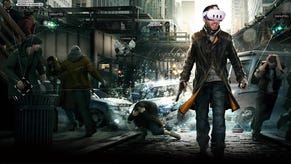Tech Analysis: Watch Dogs on PlayStation 4
How well does cutting-edge PC code translate to next-gen console?
At E3 2012, Watch Dogs kickstarted the next generation of gaming long before the PS4 or Xbox One had even been announced, joining Star Wars 1313 as one of the defining moments of the show. A short gameplay walkthrough demonstrated a highly detailed world with a slew of impressive visual effects, animation and physics work that added an extra level of realism not possible on current-gen console platforms.
Similar to many multi-platform titles targeting next-gen hardware, Watch Dogs was initially demoed using high-end PCs, rumoured to be using Nvidia GeForce GTX 680 graphics cards, which stood in for the closed-box capabilities of the Xbox One and PlayStation 4. Given the raw power in these PC-based set-ups is much greater than either of the next-gen systems, there is some concern that what people were seeing might not have been representative of the final product, with potentially higher frame-rates and higher grade visuals being the result.
These fears were seemingly confirmed when Watch Dogs was shown running on PS4 hardware for the first time at Sony's E3 press conference earlier this year. At first glance, the game appeared to lack some of the sheen of the PC code revealed a year earlier, and didn't seem to match the version seen at the PlayStation Meeting event in February either. Clearly at this point in time it's too early to tell if the technological gap between the two versions of the game will carry through to the final release of the game - months of development remain and presumably the Ubisoft teams will be optimising right up to the last minute, not to mention moving onto newer versions of the PlayStation 4 SDK - but it was a concern nonetheless.
Now we've been able to take a closer look at high-quality footage, the image quality on the PS4 version of Watch Dogs does indeed look slightly less refined than in the previous PC demo. While it's hard to confirm solid details with regards to the framebuffer from our high-bandwidth 1080i transmission stream, it would appear that the game is using a post-process AA solution of some kind on the PS4. Meanwhile, the older PC demo appears to be employing a far more aggressive edge-smoothing algorithm that delivers a much cleaner appearance at the expense of some image softness. Nvidia's TXAA solution seems to be a likely candidate here, with the smooth look of this version also featuring a visible layer of blur normally associated with the technique.
"Clearly it's early days, but judging by the high-quality footage available to us, the image quality on the PS4 version of Watch Dogs does indeed look slightly less refined than in last year's PC demo."
Away from image quality observations, performing a direct comparison becomes much harder due to the differing weather conditions of both demos and that neither showcase the same section of gameplay. Footage simply doesn't match up. That said, there are commonalities between the two. Both feature rainy night-time conditions, and in gameplay terms a number of events play out quite similarly - such as player-character Aiden Pierce hacking into the road network, causing traffic to crash.
Taking this into account, there are some clear examples where certain features have been scaled back. Depth of field is used more often in the older PC demo, and to greater effect, while the appearance of ambient lighting and shadowing also seems toned down on the PS4, reducing depth and visual flair across the scene. Weather-based touches, such as the splashes of water kicked up by the cars or by the rain hitting parts of the environment, are also dialled back on PS4, while in other areas there are subtle differences in how shader effects are handled on PC, where these elements appear slightly more pronounced. That said, it is possible that some of these differences could be down to the wetter conditions of the E3 2012 demo, where the use of more extensive effects would make sense.
The overall feeling we get is that the visual presentation is generally less refined on PS4, and as a result the world doesn't quite generate the level of immersion it did during previous showings. But despite the differences in the PS4 demo, it's also fair to say that the core rendering technology that stood out so much when Watch Dogs was first showcased still remains apparent in most areas, adding greater believability to the developer's futuristic vision of Chicago.
"Constant blasts of air from the craft's blades rock the surrounding trees and convincingly animate Aiden's jacket, with movement and collision detection influenced by the force and direction of the wind."
During the opening segment of the demo, which sees Aiden speeding across the city to evade capture, we see environments, characters and even light sources reflected on the car's bodywork in real-time, to the point where it's possible to spot individual passers-by in the reflections as he drives along. As the action progresses on foot, we begin to see just how complex the world is in Watch Dogs, with plenty of intricate details, from the variety of NPCs on offer to the way various surfaces subtly react to changing lighting conditions and environmental effects. We suspect that this is achieved via the utilisation of physically-based rendering properties, where lighting is calculated in real-time based on the physical make-up of materials in the scene.
A little later in the demo, Aiden's progress is halted by a police helicopter, energetically revealing how the wind simulation directly interacts with the game's advanced physics model. The constant blasts of air from the craft's blades rock the surrounding trees and animate the character's jacket in a highly convincing manner, with movement and collision detection influenced by the force and direction of the wind.
Ubisoft has also integrated aspects of the core technology to enhance gameplay. One of the main components of this is the unique user interface. A digital overlay maps itself across objects and characters in the game, which not only provides players with vital information, but also serves as the primary way to interact with the world around them. The system itself is simple: icons appear across the screen acting as trigger points for a number of gameplay options. These triggers are used in a number of ways, such as activating barriers that cause traffic to pile up in the road, or hacking into someone's mobile phone in order to distract them as you sneak past.
The way in which data is displayed by the UI also helps to give various locations a sense of place. When hacking into traffic cams and various video feeds in different parts of the city, the world morphs from a fully detailed and textured landscape into a comprehensive wireframe map, which conveniently transports you to the location you are surveilling in real-time, clearly showing your current location and the target destination. In this respect a lot of thought has gone into making sure that various scenes all feel like they are set in tangible places in the game world, and not just in bespoke locations that may not necessarily exist outside of a specific gameplay segment.
"The idea of game development starting on high-spec PCs before being transferred over to console hardware is an interesting set-up that is becoming more popular owing to the x86 next-gen architecture."
Another key component is the use of lighting. For example, the end of the demo sees the player hacking into the power grid, plunging the city into darkness in order to create an escape route. The only sources of light in this scene are the flashes emanating from gunfire and the soft glow of the moon reflected across the ground. Shortly after making a getaway via speedboat, the power is gradually restored and the resulting lights and illuminated scenery are reflected on the water's surface, with shadows cast by characters and environmental objects. It's impressive stuff considering how many lights appear to be in play and the way all these elements seem to be handled in real-time.
Having such a diverse range of effects and underlying subsystems dealing with animation, physics and post-processing comes with some trade-offs. In this case Ubisoft employs a smoke-and-mirrors approach when rendering certain effects. For example, rainfall is seemingly made up from layers of sprites that lack true particle physics, while explosions and the resulting smoke and particles appear to be canned, with these elements reacting in the same way during multiple car crashes in the gameplay walkthrough. The shadows cast on the car by surrounding light sources also look quite jagged and low-res in appearance.
It's interesting to note that some of these compromises can be found on both the PS4-specific demo and the previous code seen running on powerful PCs, showing that the developers are attempting to balance advances in rendering tech while ensuring smooth performance. For the most part, frame-rate is reasonable too for this stage of the game's development, with the studio still having plenty of time to optimise any major kinks that crop up before release.
The most noticeable issues here are some occasional, sudden drops in frame-rate that briefly distract from the action, along with a bit of judder from time to time. But otherwise Watch Dogs on PS4 currently manages to stick quite closely to the targeted 30fps update with no tearing to speak of. Unlike the PC build showcased at previous hands-on events, the Watch Dogs PS4 E3 demo is running solidly with v-sync enabled.
"Watch Dogs performance even at this early stage is promising - we just need to see a little more consistency in the target 30fps update."
The idea of game development starting on high-spec PCs before being transferred over to console hardware is an interesting set-up that is becoming more popular as the similarities between the two formats become progressively closer on a technical level. The use of scalable game engines and x86 hardware in both next-gen consoles and PC allows developers to target top-of-the-line systems to push real-time 3D graphics rendering further than before, and they then have the ability to customise visual quality when engineering the game to run on console hardware - a route that many next-gen multi-platform developers are actively going down in order to provide a smoother cross-platform development experience.
Square Enix's Tetsuya Nomura summed up this approach succinctly in discussing how Final Fantasy XV development was rebooted. "We're developing on DirectX 11, not based on the PS4 or the Xbox One," he said recently. "This lets us develop full-spec without worrying about individual platforms, then port it to each console in the most appropriate way. As a result, the original Final Fantasy 15 runs on a pretty high-spec PC, and how close a console gets to this original depends on its specs."
To begin with at least then, despite the clear hardware advantages enjoyed by the PlayStation 4 - its unified GDDR5 set-up for example - we should be prepared for differences between PC and console titles which may not necessarily result in superior console versions. In the case of Watch Dogs, the switch to PS4 hardware means a few drawbacks compared to year-old PC code, but in spite of this it's clear that the core experience remains intact, and obviously a cut-above the capabilities of current-gen hardware.
A more interesting thought is just how well the same gameplay experience translates over to current-generation systems, especially since dynamic AI and advanced physics appear to play such a big part in realising Ubisoft's vision. We suspect that detail and performance levels will be reduced, and that the underlying AI and other computationally intensive subsystems may be simplified to accommodate the ambitious design on much weaker 360, PS3 and Wii U hardware. Quite how much this will affect the gameplay is hard to say, but it makes you wonder just how long will this "cross-gen" period of games development endure, and at what cost? If the current-gen versions are "good enough" and financially successful as a result, will the need to service the older hardware actively hold back developers from making true next-gen games? We will be watching closely over the next couple of years with this thought in mind.

































